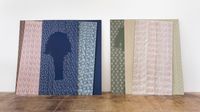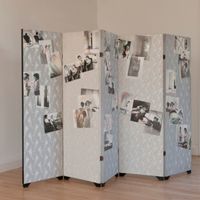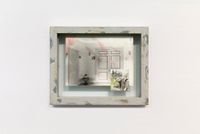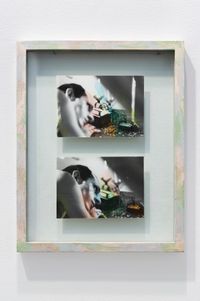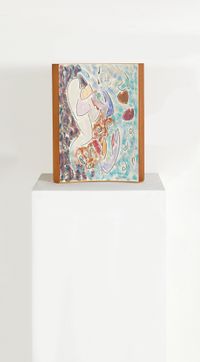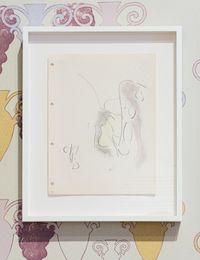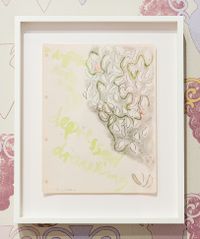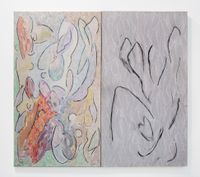Based in London, Marc Camille Chaimowicz is a French-born artist often cited for 'pioneering installation art long before the term "immersive" became a press release cliché'. Merging his artistic practice and personal life, he uses camp aesthetics, humour and tropes of femininity to form playful and generous artworks that defy easy categorisation.
Read MoreSpending the first eight years of his life in post-war Paris, Chaimowicz was raised by a Polish Jewish father and French Catholic Mother. Eventually, the family moved to London, which has remained Chaimowicz's home since.
In London, Chaimowicz studied painting at the Ealing School of Art and, later, Camberwell School of Art, before undertaking his master's degree in painting at Slade School of Fine Art. Despite the latter's esteem in painting, he became disenchanted with the medium and moved to installation and performance, inspired by a trip to Paris during the May 1968 protests.
Marc Camille Chaimowicz straddles the decorative arts, interior design and collage to share and evoke intimate and personal experiences. His works are largely maximalist, rich with pastel hues and seemingly haphazardly assembled, proffering open readings instead of one didactic message.
First exhibited in 1972, Chaimowicz's Celebration? Realife embodied his anti-disciplinary approach to installation, assembling trinkets, candles, flowers and other curiosities in a fairy-lit room. Viewers were encouraged to wander through the installation, embracing the inherent mutability of the artwork, which can never be experienced the same way twice. All the while, a selection of seventies classics by David Bowie, Jimmy Hendrix and The Doors soundtrack the encounter. After its first showing, the ephemeral contents of the installation were stored away, only to reappear in 2000, when the artist recreated the work as Celebration, Realife Revisited (1972–2000), named in reference to the Bob Dylan album, Highway 61 Revisited.
Featuring silver-lined walls like those in Andy Warhol's factory, the work is a bizarre combination of kitsch, seventies glamour—reminiscent of the glam rock scene—and curational deft that levels public and private space in one provocative performance.
Core to Chaimowicz's practice is an ability to recreate and stage environments that are both earnest and performative. After he designed the interior of his former flat on Approach Road, East London, where he lived from 1974 to 1979, Chaimowicz spent the eighties and beyond building theatrical sets with his own décor and furniture. As part of his interiors practice, he encourages daydreaming, forcing viewers to consider their own relation to the art.
Later in his career, the artist created a new work for his first major retrospective at WIELS art centre, entitled Hayes Court Sitting Room (1979–2023), which transposed the South London living room he has lived in since 1979 into the gallery. The work features existentialist literature splayed across furniture, mid-century modern design and his own printed cushions. Again, a public-private dichotomy comes to the fore.
One of the key tools in Chaimowicz's works is his stylisation of life, which often results in indulgent, effete and fanciful visual storytelling. As such, his longstanding reference, the heroine of Gustave Flaubert's novel, Madame Bovary (1856), took centre stage at his Nuit américaine (2023) exhibition in a proxy self-portrait—'portraiture differed', as he put it. The installation comprised more than 40 collages documenting his varied moods while isolating from Covid-19. To make the works, he interpreted Emma Bovary's many personas using fashion imagery and saccharine colours, a choice in keeping with his consistently female-coded aesthetics.
At times, Chaimowicz's plays with femininity and camp have been described as a queer aesthetic, although, some curators and critics deem the term too loaded for his light approach. Nonetheless, many have agreed that Chaimowicz's soft hand positions him firmly alongside his own idols: Jean Cocteau, Jean Genet and Andy Warhol.
In 2009 Chaimowicz was recipient of a Paul Hamlyn Foundation Awards for Artists grant in the Visual Arts category.
Marc Camille Chaimowicz has been the subject of both solo and group exhibitions.
Solo exhibitions include: Nuit américaine, WIELS, Brussels (2023); Zig Zag and Many Ribbons..., Musée d'art moderne et contemporain de Saint-Etienne Métropole (2022–2023); Your Place or Mine..., Jewish Museum, New York (2018); and An Autumn Lexicon, Serpentine Gallery, London (2016)
Group exhibitions include: Future, Former, Fugitive, Palais de Tokyo, Paris (2019), La Collection Thea Westreich Wagner et Ethan Wagner, Centre Pompidou, Paris (2016); and A Bigger Splash: Painting after Performance Tate Modern, London (2012)
Articles on Marc Camille Chaimowicz have been published in Ocula Magazine.
Other publications, including the New York Times, e-flux and the Art Newspaper, have also published articles on the artist.
Joe Bobowicz | Ocula | 2023
